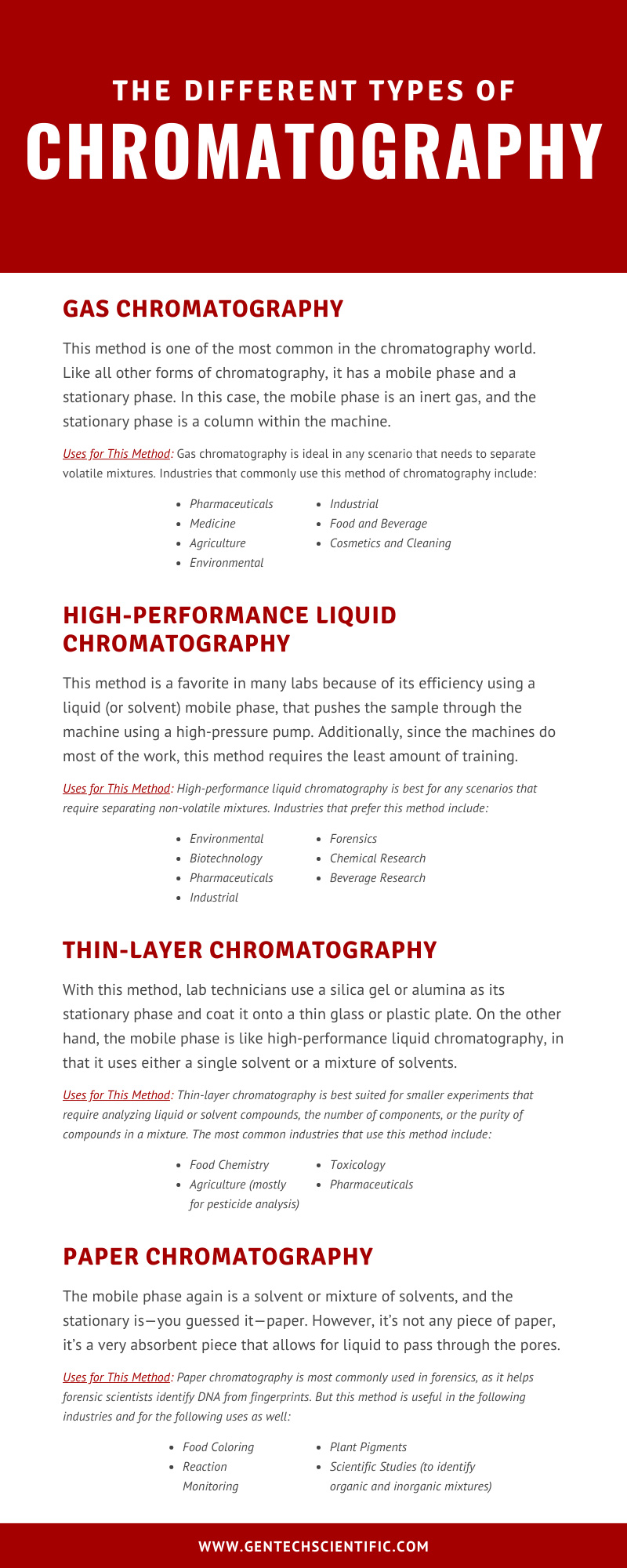Chromatography has become widely accepted in laboratories around the world, as an effective analytical technique that separates mixed compounds into their individual components. In fact, chromatography was introduced in the early 1900s, and labs still use it today because of its effectiveness and accuracy. While this method is so accurate, there are primarily four different types of chromatography: gas chromatography, high-performance liquid chromatography, thin-layer chromatography, and paper chromatography. Each has its own advantages and benefits in several industries, from healthcare to forensic science.

Gas Chromatography
This method is one of the most common in the chromatography world. Like all other forms of chromatography, it has a mobile phase and a stationary phase. In this case, the mobile phase is an inert gas, and the stationary phase is a column within the machine.
How Does It Work?
There’s a cylinder outside the machine that contains the inert gas (usually helium or some other form of unreactive gas), also known as the carrier gas. The “carrier gas” is so named because it “carries” the sample in testing through the chromatography machine. From here, the lab technician inserts the sample into the machine for testing. The sample will meet the carrier gas, and immediately turn to gas form and enter the column. Once the sample enters the column (stationary phase) in gas form, the mixed sample will begin to separate into its components and record data using a detector.
Uses for This Method
Gas chromatography is ideal in any scenario that needs to separate volatile mixtures. Industries that commonly use this method of chromatography include:
- Pharmaceuticals
- Medicine
- Agriculture
- Environmental
- Forensics
- Industrial
- Food and Beverage
- Cosmetics and Cleaning
High-Performance Liquid Chromatography
While gas chromatography is arguably the most popular chromatography method, high-performance liquid chromatography is a close second. This method is a favorite in many labs because of its efficiency using a liquid (or solvent) mobile phase that pushes the sample through the machine using a high-pressure pump. Additionally, since the machines do most of the work, this method requires the least amount of training.
How Does It Work?
The HPLC machine includes a solvent reservoir that contains the solvent (usually HPLC grade water with a small amount of acid)—also known as the mobile phase. The solvent mixes with the liquid sample and carries it through the machine using a high-pressure pump. The pump will bring the mixture to the column (the stationary phase) that contains various pore sizes and anything that passes through the pores remains the mobile phase. However, some compounds won’t pass through the pores, causing separation, and allowing lab technicians to monitor the retention time. A detector will gather this data similarly to gas chromatography, to measure and analyze the molecules.
Uses for This Method
High-performance liquid chromatography is best for any scenarios that require separating non-volatile mixtures. Industries that prefer this method include:
- Environmental
- Biotechnology
- Pharmaceuticals
- Industrial
- Chemical Research
- Beverage Research
Thin-layer Chromatography
With this method, lab technicians use a silica gel or alumina as its stationary phase and coat it onto a thin glass or plastic plate. The mobile phase is like high-performance liquid chromatography, in that it uses either a single solvent or a mixture of solvents.
How Does It Work?
The lab technician begins the process by preparing a fresh thin-layer chromatography plate. Then, the lab technician can begin placing a small amount of the sample onto a plate using a micro pipet—this step is known as spotting the plate. Then they will insert the plate into a sealed jar that contains the solvent, and over time the spots will separate at different rates. This allows lab technicians to analyze the sample by measuring the distance traveled.
Uses for This Method
Thin-layer chromatography is best suited for smaller experiments that require analyzing liquid or solvent compounds, the number of components, or the purity of compounds in a mixture. The most common industries that use this method include:
- Food Chemistry
- Agriculture (mostly for pesticide analysis)
- Toxicology
- Pharmaceuticals
Paper Chromatography
This is one of the least complex forms of chromatography, but it remains one of the most popular. The mobile phase is a solvent or mixture of solvents, and the stationary is highly absorbent specialized paper.
How Does It Work?
Paper chromatography has a rather simple process. First, the lab technician will apply the sample to the paper, then dip an edge of the paper into a solvent, such as water. From here, the solvent will travel up the paper and ultimately reach the sample, which separates the components of the sample, allowing the lab technician to measure and analyze accordingly.
Uses for This Method
Paper chromatography is most commonly used in forensics, as it helps forensic scientists identify DNA from fingerprints. But this method is useful in the following industries and for the following uses as well:
- Food Coloring
- Reaction Monitoring
- Plant Pigments
- Scientific Studies (to identify organic and inorganic mixtures)
As you can tell, the different types of chromatography are primarily the big four: gas chromatography, high-performance liquid chromatography, thin-layer chromatography, and paper chromatography. Each method offers its own benefits—some are more efficient than others depending on the needs and application of the industry.
Whatever industry you’re in, GenTech Scientific has affordable refurbished lab equipment to fit your labs unique needs. We meticulously inspect and test every piece of equipment that we sell. Our quality refurbished analytical instruments and service contracts have made us a trusted partner since 1996. Contact us today for more information – we look forward to serving you!






